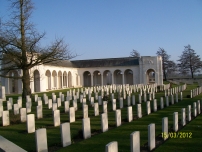| First Name: | George Horace | Last Name: | ARNOLD | |
|---|---|---|---|---|
| Date of Death: | 18/10/1914 | Lived/Born In: | Edmonton | |
| Rank: | Lance Corporal | Unit: | Royal Scots Fusiliers1 | |
| Memorial Site: | Le Touret Memorial, France | |||
Current Information:Born-Wellingborough Enlisted-Stratford
The Race to the Sea - September-October 1914 By the middle of September 1914, the Aisne battlefield had stagnated into trench warfare and in order to break this impasse, both sides tried to outflank each other in a general movement northwards. Moving up through Picardy, Artois and Flanders, the race was over by 19th October when the North Sea was reached. The Western Front, a line of trenches stretching from Belgium to Switzerland, was now a reality. Initially it was the French army that conducted this movement whilst the British Expeditionary Force remained on the Aisne but by 6 October British reinforcements were needed to help beat off German attacks around Lille. They moved north and along with reinforcements from Britain, they took up new positions in Flanders, on the left of the Allied line and much closer to the Channel ports. The battle of La Bassée This was fought by II Corps (3rd and 5th Divisions) between 10th October and 2nd November 1914 and as the name suggests it focused on an area around the town of La Bassée in northern France. It was part of the Race to the Sea and it determined the line of the Western Front in that sector. There were some initial British successes but La Bassée remained firmly in German hands. German reinforcements arrived and the village of Neuve Chapelle was captured by them. Towards the end of October, the fighting on this front died down as the attention of both armies switched to Ypres. On 18th October, 1914, 9th Brigade, 3rd Division were ordered to attack the village of Irlies while 7 Brigade advanced towards neighbouring Illies. 1st Royal Scots Fusiliers were given the objective of a chateau, south of Herlies, situated in a wood about a mile away with a considerable dip between, intersected with ditches and with enemy trenches on edge of the wood. Two companies advanced to within 500 yards under shell and rifle fire but there they stopped because the unit on their left had not kept up. Meanwhile, back at the start line, the other two companies came under heavy shell fire and suffered a number of casualties. At 5.15pm the advance was renewed and this time they got to within 200 yards of the wood but German resistance proved too strong on this occasion and half an hour later they were ordered to withdraw. This fruitless action had gained no ground but had cost 1st Royal Scots Fusiliers over 120 casualties. One of these was George Arnold. |
||||
| « Back to Search Results | ||||
| If you think any of the information shown here is incorrect, Click Here to submit your amends and comments | ||||




